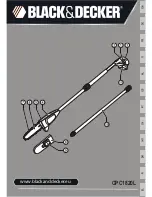
8 ENGLISH
Switch action
WARNING:
Before plugging in the tool,
always check to see that the switch trigger actu-
ates properly and returns to the "OFF" position
when released.
►
Fig.4:
1.
Lock button / Lock-off button
2.
Switch
trigger
For tool with lock button
To start the tool, simply pull the switch trigger. Release
the switch trigger to stop. For continuous operation,
pull the switch trigger, push in the lock button and then
release the switch trigger. To stop the tool from the
locked position, pull the trigger fully, then release it.
CAUTION:
Switch can be locked in "ON" posi-
tion for ease of operator comfort during extended
use. Apply caution when locking tool in "ON"
position and maintain firm grasp on tool.
For tool with lock-off button
To prevent the switch trigger from being accidentally
pulled, a lock-off button is provided. To start the tool,
press the lock-off button and pull the switch trigger.
Release the switch trigger to stop.
WARNING:
NEVER defeat the lock-off button
by taping down or some other means.
A switch with
a negated lock-off button may result in unintentional
operation and serious personal injury.
WARNING:
NEVER use the tool if it runs when
you simply pull the switch trigger without press-
ing the lock-off button.
A switch in need of repair
may result in unintentional operation and serious
personal injury. Return tool to a Makita service center
for proper repairs BEFORE further usage.
NOTICE:
Do not pull the switch trigger hard
without pressing in the lock-off button.
This can
cause switch breakage.
Interval between vise and guide
plate
CAUTION:
After adjusting the interval
between the vise and the guide plate, make
sure that the guide plate is properly secured.
Insufficient fixing may result in personal injury.
The following interval settings of the vise are available:
•
0 - 170 mm (original setting)
•
35 - 205 mm
•
70 - 240 mm
If your work requires different setting, proceed as fol-
lows to change the spacing or interval.
For LW1400
Loosen the screw on the guide plate. Move the guide
plate to the desired position then tighten the screw.
►
Fig.5:
1.
Screw
2.
Guide plate
For LW1401
Remove the two hex bolts using a socket wrench. Move
the guide plate to the desired position and secure it with
the hex bolts.
►
Fig.6:
1.
Guide plate
2.
Hex bolts
Cutting angle adjustment
CAUTION:
After adjusting the angle of the
guide plate, make sure that the guide plate is
properly secured.
Insufficient fixing may result in
personal injury.
For LW1400
Turn the lever counterclockwise. Move the guide plate
to the desired angle and fully tighten the lever.
►
Fig.7:
1.
Guide plate
2.
Lever
For LW1401
NOTICE:
When performing right miter cut,
always set the guide plate at 0 - 170 mm position.
Setting at the 35 - 205 mm or 70 - 240 mm position
hinders the movement of stopper plate, which
results in a failure cut.
Loosen the two hex bolts using a socket wrench. Turn
the guide plate to the desired angle and secure it with
the hex bolts. Be careful not to move the set angle while
securing the hex bolts.
►
Fig.8:
1.
Guide plate
2.
Hex bolts
NOTE:
The scale on the guide plate is only a rough
indication. For more accurate angle, use a protractor
or triangle ruler. Keep the handle down so that the
cut-off wheel extends into the base. At the same time,
adjust the angle between the guide plate and the cut-
off wheel with a protractor or triangle ruler.
Spark guard adjustment
For LW1401 only (country specific)
►
Fig.9:
1.
Screw
2.
Spark guard
The spark guard is factory-installed with its lower edge
contacting the base. Operating the tool in this position
will cause many sparks to fly around. Loosen the screw
and adjust the spark guard to a position at which mini
-
mum sparks will fly around.
Stopper plate
For LW1401 only (country specific)
►
Fig.10:
1.
Stopper plate
The stopper plate prevents the cut-off wheel from
contacting the workbench or floor. When a new cut-off
wheel is installed, set the stopper plate to position (A).
When the cut-off wheel wears down to the extent that
the lower portion of the workpiece is left uncut, set the
stopper plate to position (B) to allow increased cutting
capacity with a worn down wheel.
Summary of Contents for LW1400
Page 2: ...1 2 Fig 1 1 Fig 2 2 1 Fig 3 1 2 Fig 4 1 2 Fig 5 1 2 Fig 6 1 2 Fig 7 2 ...
Page 3: ...1 2 Fig 8 1 2 Fig 9 A B 1 Fig 10 1 Fig 11 1 Fig 12 Fig 13 Fig 14 3 ...
Page 4: ...4 5 6 1 2 3 Fig 15 2 1 Fig 16 1 2 Fig 17 1 2 3 Fig 18 1 Fig 19 1 2 3 4 Fig 20 Fig 21 4 ...
Page 5: ...1 2 3 4 Fig 22 1 Fig 23 Fig 24 1 Fig 25 1 Fig 26 5 ...
Page 63: ...63 ...









































